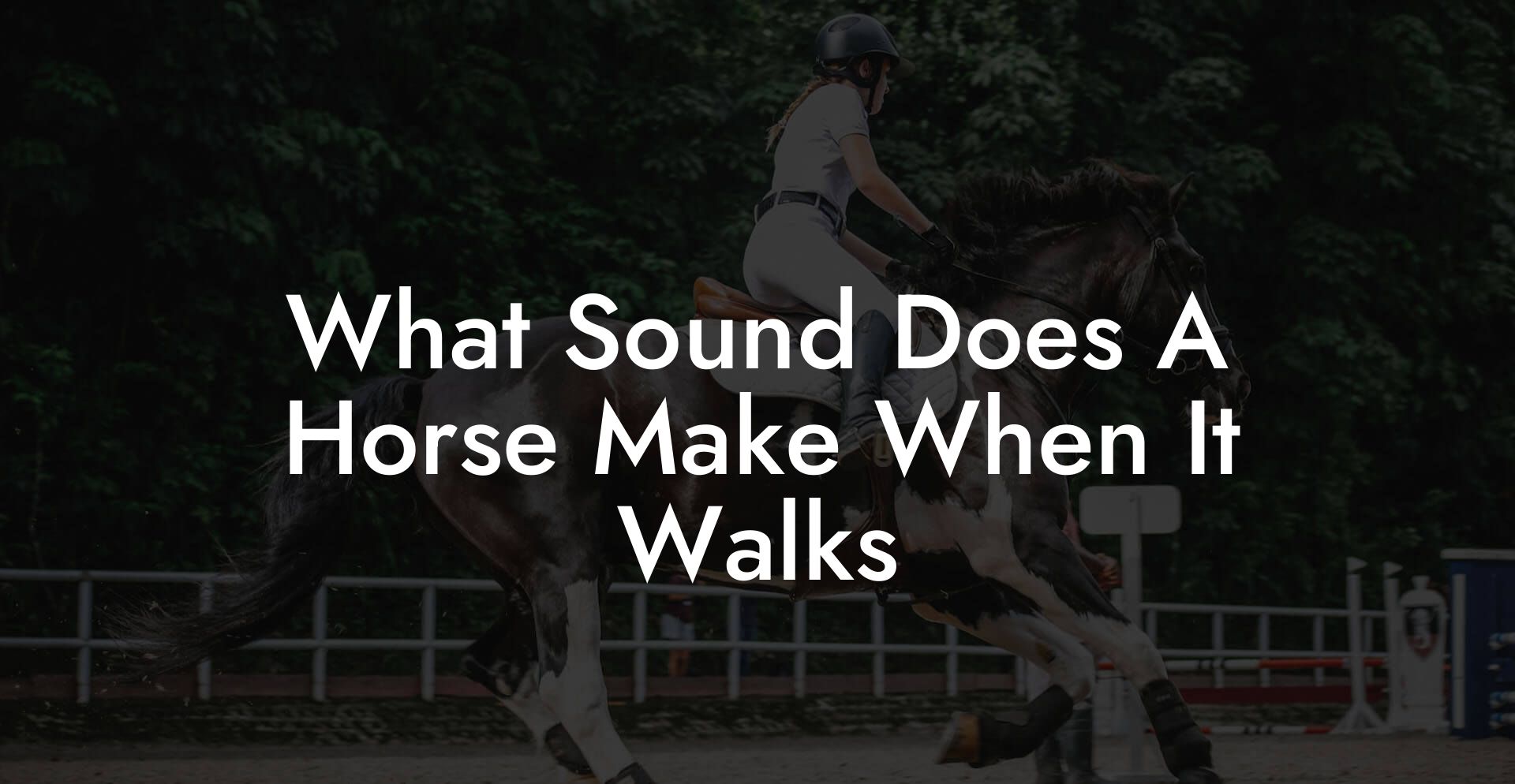Ever paused mid-scroll on your feed and caught yourself mesmerized by a rhythmic, almost hypnotic sound? Now, imagine that sound echoing across a dewy field, a series of confident, deliberate clip-clops resonating as a majestic horse takes each measured step. This isn’t just any noise; it’s the heartbeat of equine elegance, a natural percussion that speaks volumes about a horse’s well-being, style, and even personality. If you're a Gen-Z or millennial equestrian enthusiast curious about both the science behind those iconic sounds and how to care for your four-legged friend, you’re in for a deep dive into the harmonious world of equine acoustics, hoof care, and lifestyle tips that bring out the best in your horse.
Quick Links to Useful Sections
- The Intriguing World of Equine Acoustics
- The Science Behind the Sound: A Closer Look at the Clip-Clop
- How Horse Sounds Relate to Overall Health and Hoof Care
- Listening to Your Horse: Decoding the Language of Hoof Beats
- Comparing Horse Gaits: From Walk to Gallop and Everything in Between
- Horse Shoes and Barefoot Horses: How Footwear Affects the Sound
- Cultural Reflections: How the Sound of a Walking Horse Inspires Art and Lifestyle
- Caring for Your Equine Companion: The Intersection of Sound, Gait, and Hoof Health
- Tech-Savvy Tips for Modern Equine Care: Embracing Innovation and Tradition
- Maintaining Pristine Hooves: Grooming and Care Techniques for a Perfect Walk
- Resources and Community Support: Your Next Steps in Equine Excellence
The Intriguing World of Equine Acoustics
When a horse walks, its hooves create a symphony that is both comforting and mysterious. Think of it as nature’s metronome, a measured “clip clop, clip clop” that not only signals the steady pace of the animal but also tells a story about its physical condition and environment. From the rhythmic echo of a shoed horse to the softer thud of a barefooted equine, each sound is a subtle clue to the horse’s overall health and the terrain it graces.
At first glance, you might assume that all horses sound the same as they walk, but the truth is much more nuanced. Variations in sound can be influenced by factors such as hoof structure, the type of surface they traverse, and even how well their hooves are maintained. This auditory fingerprint offers a unique form of communication, if you listen closely, it might even be saying, “Hey, I’m in tip-top shape!” or alternatively, “Something might be off down here.”
The interplay between sound and movement in horses has inspired everything from epic cinematic scenes to viral TikTok videos, proving that there’s no such thing as a boring horse sound if you know where to look. Let’s break down the enigma behind this rhythmic noise and explore how it connects to broader aspects of equine care.
The Science Behind the Sound: A Closer Look at the Clip-Clop
The sound of a horse walking is a complex interplay of biomechanics and acoustics, a natural phenomenon that marries physics with biology. At the heart of this sonic signature are the hooves, the unsung heroes in equine locomotion. As a horse lifts and places each hoof, the contact between the hoof and the ground creates vibrations that travel through the air, eventually reaching our ears.
There are several elements to consider:
- Hoof Composition: The structure of a horse’s hoof, primarily composed of keratin and sensitive laminar tissue, plays a critical role in how sound is produced. When a hoof lands, its design disperses the force and minimizes impact shock, yet still generates the audible “clip clop” that we all recognize.
- Surface Texture: Whether the horse is trotting on a hard-packed dirt trail, soft pasture, or grassy field, the nature of the terrain can amplify or dampen the sound. Rougher surfaces tend to produce a more pronounced and crisp sound, while softer grounds absorb more of the impact.
- Horse Shoes vs. Barefoot: Horses with metal shoes naturally produce a louder, more resonant noise, almost a percussive beat, whereas unshod horses exhibit a gentler, more muted thud that might even seem like a whispered secret of nature.
Understanding these variables isn’t just academic, it’s a practical aspect of horsemanship that can clue you into the daily health and condition of your equine companion. Modern technology even allows for acoustic monitoring, turning these sounds into diagnostic tools that can alert caretakers to potential issues before they become serious.
How Horse Sounds Relate to Overall Health and Hoof Care
The sound a horse makes when it walks isn’t only an aesthetic pleasure, it’s a vital sign of hoof health. Every clip and clop can signal whether your horse’s hooves are in perfect condition or if there might be underlying issues that need attention. For example, an inconsistent or irregular hoof sound might suggest problems like uneven hoof wear or even early signs of laminitis.
Regular hoof care and maintenance are the cornerstones of keeping that signature sound consistent and healthy. Routine practices include:
- Trimming: Regular hoof trimming by a skilled farrier ensures that the weight is evenly distributed and that each step produces that satisfying rhythmic sound.
- Cleaning: After a long ride or a day out on various terrains, cleaning your horse’s hooves can prevent the buildup of debris and reduce the risk of infection.
- Shoeing: Proper horseshoeing, whether traditional metal shoes or modern alternatives like composite shoes, is crucial. The type of shoe and the way it is attached will influence the sound as well as the comfort of your horse during its daily trot.
Maintaining hoof health is not just about aesthetics, it’s about comfort, performance, and overall well-being. A well-cared-for hoof produces a consistent sound that is a testament to the quality of care your horse receives. It’s a small but significant symphony that echoes the commitment you invest in your horse.
For Gen-Z and millennial horse enthusiasts, blending traditional equine care with modern technology is key. Today’s riders have access to smart gadgets and mobile apps that monitor hoof temperature, pressure, and even the acoustic patterns of their horse’s gait, all of which can give early warnings if something isn’t quite right.
Listening to Your Horse: Decoding the Language of Hoof Beats
Horses communicate in more ways than we may initially realize, beyond neighing and snorting, the sound of their walk can be a window into their inner world. Sound analysis is becoming an increasingly popular method to assess and monitor equine health, making it an indispensable tool for modern riders.
When you learn to listen deeply, you can start to decode the different nuances in the clip-clop:
- Steady Rhythms: A consistent and rhythmic beat indicates that your horse's muscles, tendons, and hooves are operating in harmony. This suggests good overall health and effective training routines.
- Irregular Beats: A break in the pattern might be a sign of discomfort or instability. It could indicate slight lameness, a developing hoof problem, or even the stress of an unusual surface.
- Louder, Sharper Sounds: Occasionally, a particularly crisp sound may signal a well-maintained, heavily shod hoof, whereas a muffled noise might be expected from an unshod horse whose hoof absorbs impact differently.
Training your ears to recognize these subtle differences will not only enhance your bond with your equine partner but also help you act as an early warning system for any emerging health issues. Embrace the idea that listening to your horse isn’t just about enjoying a pleasing sound, it’s about tuning into a critical aspect of their body language and health signals.
Comparing Horse Gaits: From Walk to Gallop and Everything in Between
While we’re zooming in on the humble walk, it’s worth noting how different gaits produce distinct sounds. The walk, characterized by its gentle and deliberate beat, contrasts sharply with the canter or gallop, where the sounds become a blur of rapid-fire percussion. Each gait tells a different story:
- The Walk: Slow, steady, and rhythmic, this gait emphasizes control and balance. A typical walking sound is methodical and soothing, offering insights into hoof alignment and surface traction.
- The Trot: A two-beat gait where the hooves hit the ground in pairs, often producing a syncopated sound that can be either soft or pronounced, depending on stride length and surface conditions.
- The Canter: A three-beat gait that hints at elegance and power, typically accompanied by a mix of soft thuds and brisk clacks that signal speed blended with grace.
- The Gallop: The fastest of the paces, where the sound becomes a rapid staccato, a burst of energy that’s as thrilling as it is dynamic.
For equestrians keen on understanding the nuances of their horse’s performance, differentiating these sounds can help tailor training techniques and care routines precisely. The walk, with its deliberate cadence, is an exceptional starting point for both new riders and seasoned enthusiasts to learn about the natural rhythms and well-being of their horses.
Whether you’re assessing your horse’s gait during a morning pasture stroll or during a focused training session, paying attention to these audible cues can lead to a proactive approach in addressing any subtle shifts that could signify health or performance issues.
Horse Shoes and Barefoot Horses: How Footwear Affects the Sound
One of the most fascinating aspects of equine acoustics is how horseshoes dramatically change the soundscape of a horse's walk. Metal shoes add a layer of percussion, a bright, metallic "clip clop" that commands attention. In contrast, a barefoot horse, free from the rigid exoskeleton of a horseshoe, produces a softer, almost cushioned thud as its natural hoof structure meets the ground.
The choice between shoeing and leaving a horse barefoot is rarely just skin-deep (or hoof-deep!). It involves careful consideration of the horse’s activity level, the surface it walks on, and potential health issues. For active horses in competitive arenas, shoes can provide durability, traction, and an unmistakable sound that underscores their athletic prowess. On the other hand, horses that roam natural pastures may benefit from the softer sound and flexible comfort of a barefoot state, which some proponents argue promotes better natural hoof wear and circulation.
As a responsible horse caretaker, tuning into these sound differences isn’t just about auditory aesthetics, it’s about adapting your care routine to what best suits your horse’s needs. Monitoring changes in their gait sound can indicate if a change in shoeing style or technique might be necessary, blending modern farrier science with the ancient understanding of equine nature.
Cultural Reflections: How the Sound of a Walking Horse Inspires Art and Lifestyle
The “clip clop” of a horse’s walk has echoed through history, celebrated in literature, art, and even modern memes. From classic Western films that dramatize horseback pursuits to contemporary Instagram reels powered by trending sound clips, this rhythmic beat resonates with people across generations.
In many cultures, the sound of a horse walking is synonymous with freedom and unbridled natural beauty. It appears in poetry as a metaphor for steady resolve, in music as a background track for epic journeys, and in everyday life as a reminder of nature’s pace, one not dictated by the frantic hurry of modern society.
Gen-Zs and millennials, who thrive on authentic, raw expressions of nature and well-being, find solace in these sounds. They serve as digital detox moments: a quick mental escape to a countryside where the only notifications are the soothing beats of hooves on a dirt trail. Embracing these moments can foster a deeper connection to the animals we care for, reminding us that every sound carries meaning and beauty.
Caring for Your Equine Companion: The Intersection of Sound, Gait, and Hoof Health
Understanding the sound of your horse’s walk provides a unique bridge between observational care and active management of equine health. A vigilant rider listens not only for the aesthetic pleasure of rhythmic hoofbeats but also for subtle changes that hint at discomfort or imbalances. This auditory insight can be a powerful addition to your toolkit for horse care.
Integrating modern diagnostic techniques with good old-fashioned sensory observation is the way forward. Today, wearable devices for horses can monitor gait patterns, while smartphone apps analyze the intensity, frequency, and cadence of hoof sounds. These innovations empower owners to track trends in their horse’s movement, providing early indicators for issues such as uneven trimming, shoeing problems, or even early signs of lameness.
Pairing these tools with regular farrier check-ups and attentive daily care creates a proactive care routine. This holistic approach ensures that your horse not only sounds healthy but also feels great from hoof to heart.
Tech-Savvy Tips for Modern Equine Care: Embracing Innovation and Tradition
As a modern horse owner, blending the traditions of equine care with innovative technology is a win-win. Here are some practical tips to get you started:
- Invest in Smart Hoof Monitors: These gadgets attach to your horse’s hoof to record and analyze sound patterns, offering real-time insights into gait and potential issues.
- Use Apps for Tracking: There are mobile apps specifically designed for horse care that allow you to log grooming, shoeing, and even rhythmic data from your equine companion’s walk.
- Stay Updated with Online Communities: Digital forums and social media platforms filled with fellow riders, farriers, and equine experts are great places to learn new techniques, share experiences, and stay informed about the latest trends in hoof care.
- Blend Old and New: Continue practicing time-tested care routines (like regular trimming and cleaning) while gradually integrating tech tools that provide additional layers of insight.
With these tech-savvy strategies, you can ensure that your horse’s rhythmic walk remains a delightfully consistent indicator of health and vitality, bridging the gap between tradition and modern innovation.
Maintaining Pristine Hooves: Grooming and Care Techniques for a Perfect Walk
The foundation for that perfect, soothing horseback walk begins at the hoof. Just as we care for our skin and nails, horses require dedicated attention to ensure their hooves are resilient and healthy. Here are some tips for optimal hoof care:
- Daily Cleaning: Use a hoof pick after every ride to remove mud and debris. This practice not only preserves the natural sound but also prevents bacteria buildup that can lead to infections.
- Regular Trimming: Work closely with a skilled farrier to schedule routine hoof trims. This helps maintain an even balance and ensures that the weight is properly distributed with each step, preserving that rich clip-clop.
- Moisturization and Conditioning: In dry climates, consider using specialized hoof conditioners that help maintain the natural moisture balance, keeping the hooves flexible and less prone to cracking.
- Proper Shoeing Decisions: Evaluate whether your horse benefits from metal shoes, composite alternatives, or the freedom of going barefoot based on its activity, environment, and overall hoof health. Changing shoe types as needed can significantly affect how your horse sounds when it walks.
- Dietary Considerations: The health of a horse’s hooves is intrinsically linked to its diet. Ensure a well-balanced diet rich in biotin, omega fatty acids, and essential minerals that support hoof growth and strength.
These practices, combined with constant monitoring of the sounds your horse makes, can be the difference between a routine check-up and early detection of potential issues. Remember, the sound is not just music to your ears; it’s a message from your horse.
Resources and Community Support: Your Next Steps in Equine Excellence
Embarking on your journey of enhanced equine care doesn’t have to be a solo ride. In today’s digital age, countless resources and vibrant communities are ready to support you every step of the way. Whether you're a newbie trying to decode the subtle harmonies of hoof sounds or a seasoned rider seeking the latest in horsemanship technology, here are some recommended steps:
- Join Online Forums and Social Media Groups: Platforms like Reddit, Facebook, and specialized equine care apps provide spaces to share experiences, ask for advice, and discover innovative tips directly from fellow horse enthusiasts.
- Attend Webinars and Live Q&A Sessions: Many veterinary schools and equestrian centers now offer live online sessions that delve into modern techniques for hoof care, gait analysis, and advanced equine health monitoring.
- Subscribe to Equestrian Blogs and Podcasts: Keep up-to-date with the latest trends in horse care, technology, and training by tuning into popular equine podcasts and following top-rated blogs maintained by experts in the field.
- Visit Local Equestrian Centers and Farrier Workshops: Hands-on learning from professionals gives you real-time insights into the practical aspects of hoof care and the acoustic cues that indicate your horse's health status.
- Download Equine Health Apps: Leverage technology by using mobile applications that track your horse’s diet, daily exercise, and even hoof sound patterns to alert you of any deviations in its usual rhythm.
By connecting with these communities and tapping into a wealth of digital and local resources, you can elevate your care regimen, ensuring that every clip-clop of your horse’s walk is a testament to exceptional, attentive care. Empower yourself with knowledge and become an active participant in the thriving world of modern equine wellness.













